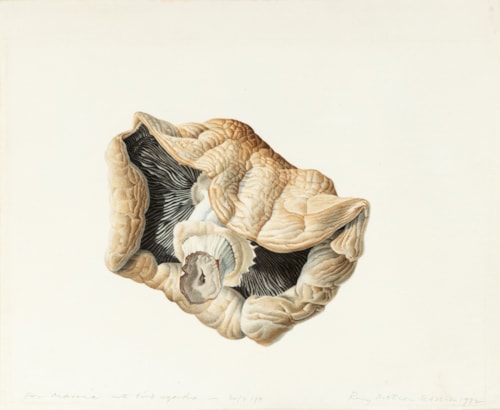
Rory MCEWEN
Greenlaw 1932 - London 1982
Biography
One of the finest botanical artists of the 20th century, the artist and musician Roderick (always known as Rory) McEwen grew up at Marchmont House in the Scottish Borders and was introduced to flower painting at the age of eight by a French governess. At Eton College he came under the tutelage of the art master Wilfrid Blunt, who was a historian of botanical art and published his seminal book The Art of Botanical Illustration in 1950. Blunt instilled in the young McEwen an appreciation of the history of botanical painting from its earliest days, and he carefully studied the works of flower and plant painters from the 16th century to the 19th century. As he later wrote to Blunt, ‘I have never really been interested in botanical illustration per se, but rather in that moment when painting starts to breathe poetry.’ His time at Eton was the only period of formal artistic training that McEwan received, however.
McEwen began painting botanical illustrations on vellum in the early 1950s, while studying at Cambridge. In 1952, at the suggestion of Sacheverell Sitwell, McEwen was commissioned to provide a series of watercolours as illustrations for C. Oscar Moreton’s Old Carnations and Pinks, eventually published in 1955. A few years later he completed seventeen large watercolours on vellum for Moreton’s The Auricula, Its History and Character, which appeared in 1964. By this time McEwen had had his first solo exhibition, at the Durlacher Bros. Gallery in New York in 1962. The exhibition brought him to the attention of two notable patrons, Rachel Lambert ‘Bunny’ Mellon and Jacqueline Kennedy, and McEwen’s watercolours soon hung in the private rooms of the White House. A second exhibition of McEwen’s botanical studies took place at the Galerie André Weil in Paris in 1964, and later shows were mounted at galleries in New York, Edinburgh and London. Throughout the decade of the 1970s his watercolour studies of fruits, flowers and leaves were shown at the Redfern Gallery in London, while he also produced superb drawings of tulips and fritillaries intended as book illustrations.
Much of McEwen’s work is painted in watercolour or vellum, which endowed his works with a particular luminosity. As has been noted, ‘Rory McEwen’s unique talent was to combine botanical accuracy, artistic elegance and superb technique in the same painting. He never made plants too formal, stylized or unnaturally perfect, yet he never compromised with perfection in technique nor in careful examination and understanding of the details of the subject. In these qualities he will be seen as the equal, if not the superior, of the great botanical artists of the past.’ He worked in his studio for long hours with deep concentration, listening to music on headphones and often wearing surgeon’s eyeglasses with magnifying lenses attached to them to enable him to study his subjects more closely. Apart from his botanical studies, McEwen also produced a handful of etchings of animal, plants and flowers, and created several modernist abstract sculptures in Perspex, glass and steel.
Apart from his work as an artist, McEwen was equally talented, and as highly regarded in his lifetime, as a musician. A gifted 12-string guitarist and folk singer, he performed regularly, often with his brother Alexander (known as ‘Eck’), in clubs and on television in Britain and America in the late 1950s and early 1960s. He served as art editor of The Spectator magazine and travelled extensively; to Japan (where his work was very popular), Afghanistan, India, Nepal, Tibet and Bhutan. McEwen’s last Redfern exhibition took place in 1981, the year before his untimely death from cancer at the age of fifty. Botanical drawings and watercolours by McEwen are today in the collections of the Aberdeen Art Gallery, the Fitzwilliam Museum in Cambridge, the Scottish National Gallery of Modern Art in Edinburgh, the Museum of Modern Art in New York, the Norton Museum of Art in West Palm Beach, the Hunt Institute for Botanical Documentation in Pittsburgh, and in numerous private collections.


